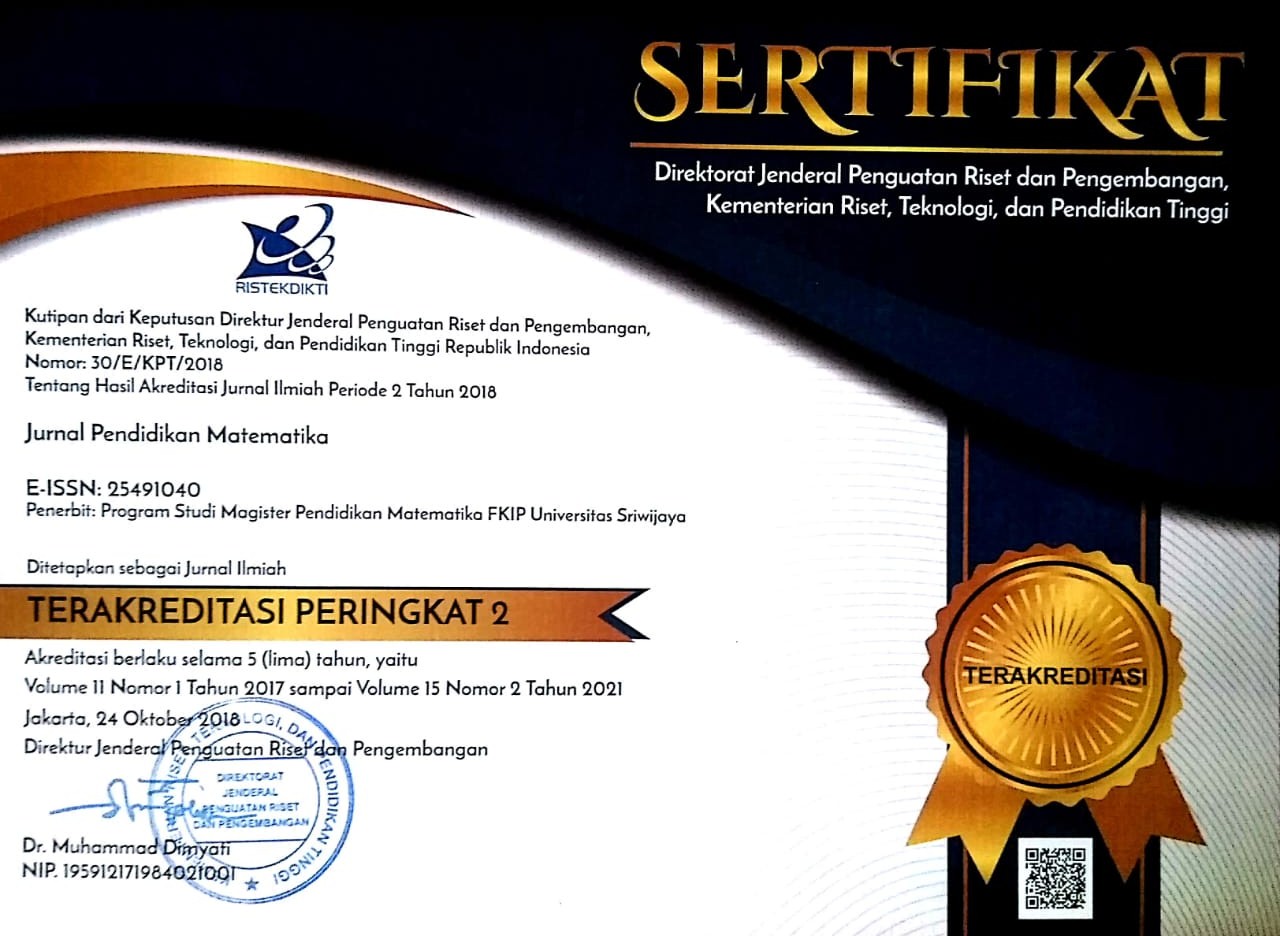The Development of PISA Questions and Activities Using Social Distancing Context During Pandemic
Abstract
The emergence of this research is caused by the low mathematical literacy of students in Indonesia. This study aims to obtain valid, practical, and have potential effects of PISA type questions and activities using social distancing context during pandemic. This study is design research with the type of development studies which consist of two main stages, including preliminary design and formative evaluation. This study took a special research subject for grade IX junior high school students aged 14-16 years in the city of Palembang. Analysis of the results of this study was carried out qualitatively based on data in the field obtained in the form of interviews, photos and videos to see student activities in working on questions and activities. From this study, the results obtained include one type of activity and one evaluation question of the results of developing PISA type questions and activities with the context of social distancing during a pandemic that grade IX students can use to develop their mathematics literacy skills. In conclusion, PISA type questions and activities with the context of social distancing during the pandemic can be used for the learning process in the classroom to improve students' mathematical literacy.
Keywords
Full Text:
PDFReferences
Bakker, A. (2018). Design research in education: A paractical guide for early career researchers. Routledge.
Bakker, A., & Wagner, D. (2020). Pandemic: Lessons for today and tomorrow? Educational studies in Mathematics. 104(1), 1–4. https://doi.org/https://doi.org/10.1007/s10649-020-09946-3
Efriani, A., Putri, R. I. I., & Hapizah. (2019). Sailing context in PISA-like mathematics problem. Journal on Mathematics Education, 10(2), 256–276. https://doi.org/https://doi.org/10.22342/jme.10.2.5245.265-276
Jamilah., Sukitman, T, & Fauzi, M. (2021). Opportunities and challenges of digital learning media during the COVID-19 Pandemic in Primary School. Jurnal Ilmiah Pendidikan MIPA, 11(2), 191–200. https://doi.org/http://dx.doi.org/10.30998/formatif.v11i2.9732
Machaba, F. M. (2016). The concepts of area and perimeter: Insights and misconceptions of Grade 10 learners. Journal of the Association for Mathematics Education of South Africa, 37(1), 1–11. https://doi.org/http://dx.doi.org/10.4102/pythagoras.v37i1.304
Magen, N., & Nagar. (2016). The effects of learning strategies on mathematical literacy: A comparison between lower and higher achieving countries. International Journal of Research in Education and Science, 2(2). https://doi.org/http://dx.doi.org/10.21890/ijres.77083
Mahardita, J. (2021). COVID-19 context PISA model question design: Expert review [in Bahasa]. Journal of Education in Mathematics, Science, and Technology, 4(1), 11–20. https://doi.org/https://doi.org/10.30631/jemst.v4i1.43
Meryansumayeka, Zulkardi, Putri, R. I. I., & Hiltrimartin, C. (2020). Secondary students’ higher order thinking skills in solving PISA-like mathematical taks. Journal of Physics Conference Series, 1480(1). https://doi.org/https://doi.org/10.1088/1742-6596/1480/1/012034
Munayati, Z., Zulkardi, & Santoso, B. (2015). Study of mathematics textbook questions for class X curriculum 2013 using the PISA framework [in Bahasa]. Jurnal Pendidikan Matematika, 9(2), 188–206. https://doi.org/http://dx.doi.org/10.22342/jpm.9.2.2161.188-206
NCTM. (2000). Princples and Standards for School Mathematics. Reston, VA: NCTM.
Nusantara, D. S., Zulkardi, & Putri, R. I. I. (2021). Designing PISA-like mathematics task using a COVID-19 context (Pisacomat). Jurnal On Mathematics Education, 12(2), 349–364. https://doi.org/https://doi.org/10.22342/jme.12.2.13181.349-364
OECD. (2019). Indonesia – Country Note – PISA 2018 Results. Retrieved from https://www.oecd.org/pisa/publications/PISA2018_CN_IDN.pdf
Piaget, J. (2002). Cognitive Development Level [in Bahasa]. Jakarta: Gramedia.
Putri, R. I. I., & Zulkardi. (2018). Designing PISA-like mathematics task using Asian Games context. Jurnal on Mathematics Education, 11(1), 135–144. https://doi.org/https://doi.org/10.22342/jme.11.1.9786.135-144
Rahayu, T. (2018). Application of inquiry based learning to improve mathematics learning outcomes of Grade VI Students of SD Negeri 2 Tulungrejo Tulungagung [in Bahasa]. Jurnal Riset Dan Konseptual, 3(2). https://doi.org/http://dx.doi.org/10.28926/briliant.v3i2.172
Saputri, N. W., Turidho, A., Zulkardi, Darmawijoyo, & Somakim. (2020). PISA question design uncertainty content and data context of the spread of COVID-19 [in Bahasa]. Jurnal Pendidikan Matematika, 8(2), 106–118. https://doi.org/http://dx.doi.org/10.20527/edumat.v8i2.8564
Sari, R. H. N., & Wijaya, A. (2017). Mathematical literacy of senior high school students in Yogyakarta. Jurnal Riset Pendidikan Matematika, 4(1), 100–107. https://doi.org/http://dx.doi.org/10.21831/jrpm.v4i1.10649
Sepriliani, S. P., Zulkardi, Putri, R. I. I., Samsuryadi, Alwi, Z., Jayanti, Nusantara, D. S., … Putri, R. P. (2022). The development of PISA-based numerical problem using the context of religious day during the Pandemic. Jurnal Pendidikan Matematika, 16(2), 157–170. https://doi.org/10.22342/jpm.16.2.16010.157-170
Sholihah, D. A., & Shanti, W. N. (2017). Mathematical critical thinking disposition in learning using the Socratic Method [in Bahasa]. Jurnal Karya Pendidikan Matematika, 4(2), 1–7. https://doi.org/https://doi.org/10.26714/jkpm.4.2.2017.1-9
Siregar, N. F. (2019). Analysis of student errors in solving math problems [in Bahasa]. Jurnal Ilmu-Ilmu Pendidikan Dan Sains, 7(1), 3–13. https://doi.org/https://doi.org/10.24952/logaritma.v7i01.1660
Stacey, K. The PISA View of Mathematical Literacy in Indonesia (2011). IndoMS. J.M.E, 2 (2), 95-126. https://doi.org/10.22342/jme.2.2.746.95-126.
Tohir, A., & Mashari, A. (2020). The effectiveness of the Inquiry Learning Model in improving student learning outcomes IV SDN 27 Tengineneng [in Bahasa]. Jurnal Ilmiah Sekolah Dasar, 4(2), 48–58. https://doi.org/http://dx.doi.org/10.23887/jisd.v4i1.23015
Zulkardi, Meryansumayeka, Putri, R. I. I., Alwi, Z., Nusantara, D. S., Ambarita, S. M., Maharani, Y., & Puspitasari, L. (2020). How students work with PISA-like mathematical tasks using COVID-19 context. Jurnal on Mathematics Education, 11(3), 405–416. https://doi.org/https://doi.org/10.22342/jme.11.3.12915.405-416
Zulkardi, Nusantara, D. S., & Putri, R. I. I. (2021). Designing PISA-like task on uncertainity and data using COVID-19 Context. Journal of Physics, 10(1), 81–92. https://doi.org/http://dx.doi.org/10.1088/1742-6596/1722/1/012102
DOI: https://doi.org/10.22342/jpm.16.3.17358.239-256
Jl. Srijaya Negara, Bukit Besar
Palembang - 30139 Indonesia
Jurnal Pendidikan Matematika is licensed under a Creative Commons Attribution-NonCommercial-ShareAlike 4.0 International License.
Indexed in:


